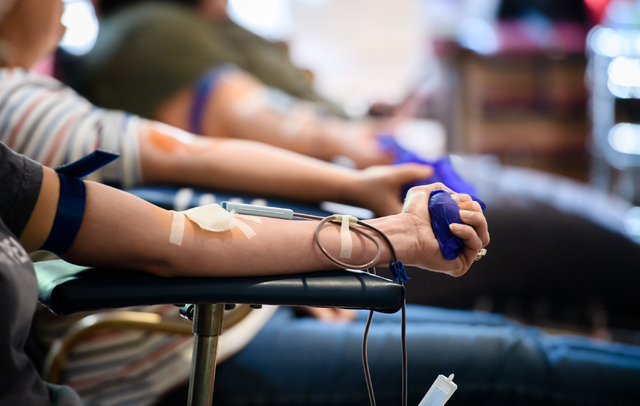
By Rosalind Fournier | UAB News
The number of blood donors is at an all-time low going back 20 years, according the American Red Cross. This has led to a critical shortage of blood supplies across the country — to the point that the organization declared an emergency blood shortage in January 2024.
Investigators at UAB recently published research in JAMA which shows that the nation’s ability to treat patients who require blood on any given day is in peril. Our nation’s ability to treat the patients who require blood on any given day — from victims of mass-casualty events to those undergoing treatment for cancer — is in serious peril, according to a new paper, “The Bloody Transfusion Problem,” published in the Journal of the American Medicine Association (JAMA).

John B. Holcomb, M.D., professor in the University of Alabama at Birmingham Division of Trauma and Acute Care Surgery and lead author, paints a picture that extends beyond technical research into the economics, politics, and logistics of solving the country’s problems surrounding blood supply and usage. These include the alarmingly inadequate supply of blood overall alongside the need for shelf-stable blood products; the near-absence of blood products available in prehospital settings; and the need to sustain consistent research funding for trauma studies of hemorrhagic shock.
Key findings show that fewer than a third of hospitals which received blood components from the American Red Cross in 2019 routinely had platelets ready for transfusions. Among prehospital systems including helicopters and ground ambulances, fewer than one percent have prehospital transfusion programs. And overall, throughout the United States, the rate of blood donation is falling. In fact, the Red Cross recently declared an emergency blood shortage and reported that the number of U.S. blood donors is at all-time low going back 20 years. The consequences are amplified by a staggering amount of trauma, currently the leading cause of life-years lost among people between one and 75 years of age and costing the United States billions annually.
Translating trauma care
Holcomb has been studying these issues for most of his career, which spans from treating soldiers on the battlefield to civilian trauma care; Holcomb has a wealth of experience as a retired army colonel who served as the Commander of the United States Army Institute of Surgical Research and Trauma Consultant for the Army Surgeon General from 2002 to 2008.
Holcomb describes a seminal moment early in his trauma career. During his surgical residency, he had been trained to resuscitate patients primarily with crystalloid, followed by red cells, plasma, and platelets in sequential order.
“The patients became incredibly deluded and coagulopathic,” Holcomb said.
After he first deployed with the Joint Special Operations Command in Somalia in 1983, he started giving fresh whole blood to trauma patients.
“It was remarkable to see the physiologic effect, the lack of coagulopathic bleeding, and how well the patients did with fresh, whole blood available,” Holcomb said.Holcomb identifies that experience as an impetus for his ongoing efforts to advocate for changes in the U.S. civilian and military blood supply. The improvements in outcome Holcomb witnessed on the battlefield have been confirmed by government-sponsored studies, resulting in changes in practice at trauma centers around the world.
Still, Holcomb estimates it will require hundreds of millions of dollars to mitigate injury’s societal impact and create lasting change.
Waging the battle
Meanwhile, Holcomb sees much work left to be done to address the other problems outlined in his research. One issue of grave concern surrounds care in the prehospital setting.
According to the paper, “Although the use of prehospital blood products is standard of care within the deployed Department of Defense trauma system only a limited number (<1 percent) of civilian prehospital systems have implemented prehospital transfusion programs despite high-quality evidence supporting a mortality benefit in this setting.”
Meanwhile, 33 percent of hospitals themselves that received blood components from the American Red Cross in 2019 did not routinely have platelets ready to transfuse to bleeding patients.
There are also issues of disparity, with rural, minority, and disadvantaged trauma patients impacted more heavily than others.
“Patients who already have a disproportionate death rate also disproportionately do not have blood available in the EMS agencies that serve their zip codes,” Holcomb said. “There is an economic disparity that trickles down into health disparities and causes more people to die unnecessarily. It’s that simple.”
The requirements of cold-chain blood storage present an additional challenge in civilian, especially prehospital, and military applications.
“Imagine a doctor in Syria working out of a backpack,” Holcomb said. “Keeping the blood products cold is difficult.”
To overcome this, Holcomb is a strong advocate for getting shelf-stable blood products to market, a goal multiple countries around the world have already achieved. He is optimistic that shelf-stable blood products will be available in U.S. within the next couple of years.
“The units donated are going down while the need for blood goes up,” Holcomb said, pointing to the estimation presented in the paper that more than 55,000 additional donors will be required for the new prehospital blood program implementation alone.
The paper advocates for increased reimbursement for blood-collection centers as well as payment for donors.
“The testing today is so good that I see no problem with people selling blood and improving the supply of blood product in the United States,” Holcomb said.
The paper states that while the investment required to address the multifaceted issues surrounding the nation’s blood supply, policies, and protocols is significant, improving care is cost effective over the long term. As it is, the costs of trauma to the U.S. are estimated $4.2 trillion a year. The nonmonetary costs are immeasurable.
“This is not abstract,” Holcomb said. “It’s personal. This involves our kids, our spouses, and our parents as they go about their everyday lives. The death rate from lack of blood prehospital alone is extraordinary and can be prevented.”
He added that these issues have been discussed within the transfusion and trauma communities for years, but he hopes the publication will reach a wider audience and ultimately affect greater change.
Co-authors of “The Bloody Transfusion Problem” are William K. Hoots, M.D., professor emeritus in the Departments of Pediatrics and Internal Medicine at the University of Texas Medical School at Houston and Travis Polk, M.D., director of the Combat Casualty Care Research Program, U.S. Army Medical Research and Development Command, Uniformed Service University of Health Sciences in Fort Detrick, Maryland.
Visit www.redcross.org/give to find a location near you where you can donate blood.




